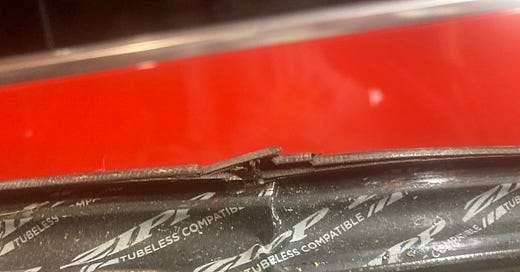TPU Tubes, Carbon vs. Aluminum Rims, Tubeless vs. Tubular Rolling Resistance
Which rim material is safer for tubeless road tires?
Dear Lennard,
Two things about TPU tubes:
1. It should be sized pretty correctly. I think they don't like to be overstretched and downsizing is also not good.
2. I guess they should be avoided with rim brakes, because heat + TPU is a potentially really bad combo.
I haven't ever used one.
Read all about them though.
Alan
Dear Lennard,
I’ve been reading with interest your series of emails/articles about tubeless tires and carbon rims. I’ve been riding aluminum rims (hooked, both road and gravel) with tubeless tires, no tubes, and haven’t had any problems. I also generally ride in Alaska, where it doesn’t get as hot as many places. Does your analysis change with aluminum rims?
Matt
Dear Matt,
Oh yes, it does.
The crux of the issue is that tubeless tires remain mounted and inflated only when the diameters of the rim bead seat and the tire bead match. If the diameter of the rim bead seat is less than that of the tire bead, the tire immediately loses all its inflation pressure, the beads consequently dislodge and drop into the center valley of the rim, and the tire often comes completely off the rim.
In any case, it’s impossible to control the bike if the diameter of the rim bead seat suddenly becomes reduced, and that is exactly what happens if the tire hits an obstacle hard enough to crack the rim. The tension on the spokes pulls the rim into a smaller diameter as soon as it cracks.
By contrast, impacting an aluminum rim just as hard may instead only dent the rim wall without affecting the diameter of the rim bead seat. The dent in the rim wall obviously compromises the rim/tire interface, but it does not necessarily result in instant air loss followed by instant tire loss.
― Lennard
Dear Lennard,
With regard to tubular tires for road racing, wasn't it found that they actually produce significantly higher rolling resistance than tubulars? I got the feeling the pros like tubeless for both flat protection and rolling resistance.
Steve
Dear Steve,
Addressing your second sentence first, flat protection is an advantage of tubeless clinchers over tubulars (non-tubeless ones) for small punctures due to road debris. However, as we’ve seen in recent posts here, tubulars hold an advantage over tubeless clinchers when it comes to flats due to hard impacts.
As for your question, yes, high-end tubeless clinchers generally exhibited a lower coefficient of rolling resistance (CRR) in our tests at Wheel Energy than high-end tubulars. As I described in a recent post, as inner rim width increases, the CRR of the same tubeless clincher likely goes up.
Keep reading with a 7-day free trial
Subscribe to Technical Q&A with Lennard Zinn to keep reading this post and get 7 days of free access to the full post archives.





